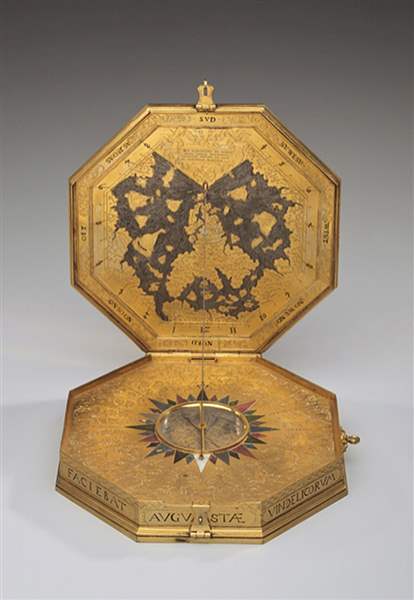
‘CULTURAL SHIFT’ IN PROCEDURES
Toledo museum to give up prized German artifact
Astrolabe likely stolen after WWII
2/19/2015
TMA’s president said the return of this 450-year-old astrolabe resulted from scrutiny into the history of the museum’s collection.
TOLEDO MUSEUM OF ART

TMA’s president said the return of this 450-year-old astrolabe resulted from scrutiny into the history of the museum’s collection.
Recognizing a “cultural shift in how museums conduct themselves,” the Toledo Museum of Art said Wednesday it has voluntarily agreed to return a rare, 450-year-old piece of German art that it recently learned was likely stolen from a museum after World War II.
The device, called an astronomical compendium or astrolabe, was used to tell time and to make astronomical calculations.
There are other devices like it. But what makes this one unique is that it was made by Christoph Schissler the Elder in 1567, probably as commission for the Kunstkammer of the Prague Court.
It got passed around as a “spoil of war” on a couple of occasions before winding up in the Gotha Museum in Gotha, Germany, which the Americans occupied during World War II. Many of the Gotha collections were moved in the summer of 1945 to the former Soviet Union once it had authority over Gotha transferred to it by the United States.
The Schissler-made device, for reasons unknown, was one of the few artifacts from that museum that didn’t make it to the Soviet Union.
Somehow, it wound up in the hands of Rosenberg & Stiebel, a New York art dealer, which in 1954 was acquired by a man named Otto Wittmann for the Toledo Museum of Art’s collection. The sale price was $6,500.
In May, 2013, the TMA received a letter from Martin Eberle, Gotha Museum director, stating that the museum in Germany had learned about the piece being in Toledo and thought it belonged to the Gotha Museum.
Two months later, after reviewing documentation provided, Brian Kennedy, Toledo museum president, director, and chief executive officer, notified the Gotha Museum that the piece that had been on display at the Toledo Museum of Art for years was “most likely one and the same.”
Arrangements began for a repatriation date. That now appears likely to be in March or April. The artifact is no longer on exhibit.
In an interview with The Blade on Wednesday, Mr. Kennedy acknowledged it is the fourth time since 2010 the Toledo Museum of Art has made arrangements to return art it later found out had belonged to someone else.
But unlike earlier cases, this is one that involves no government bureaucracy or complications raised by potential thieves or distributors awaiting trial. It is, as Mr. Kennedy noted, simply an agreement between two museums to get a historically valuable piece back to its rightful owner.
“We’ve recognized there’s been a cultural shift in how museums conduct themselves,” Mr. Kennedy said. “There’s much more scrutiny in how museums obtain their objects and transparency now.”
He said the TMA had made it museum policy over the past 10 years to look harder into the ownership history of every piece.
“This was a one-of-a-kind scientific device,” Mr. Kennedy said. “It’s sad to see it go, but it’s not ours.”
The device was used to tell time and make astronomical calculations less than 50 years after Ferdinand Magellan’s expedition circumnavigated the globe by sea for the first time, according to the Toledo Museum of Art.
The Gotha Museum supplied “extensive documentation, including photographs, which convinced TMA officials that the Toledo astrolabe was the same one missing since 1945,” the TMA’s statement said.
In return, the Gotha Museum will offer the Toledo museum an opportunity to borrow some of its other pieces.
The most recent incident like this occurred last fall, when the Toledo Museum of Art said a rare bronze statue of the Hindu diety Ganesh would be returned to India.
The Toledo Museum of Art, founded in 1901, paid $245,000 for that piece in 2006. It is believed to be nearly 1,000 years old, and is believed to have been stolen from an Indian temple.
The museum purchased it from the New York art gallery of Subhash Kapoor, who was arrested in Germany in 2011 and extradited to India the following year on charges of forgery, illegal exportation, and criminal conspiracy.
Mr. Kennedy said that case is still pending.
Contact Tom Henry at: thenry@theblade.com, 419-724-6079, or via Twitter @ecowriterohio.